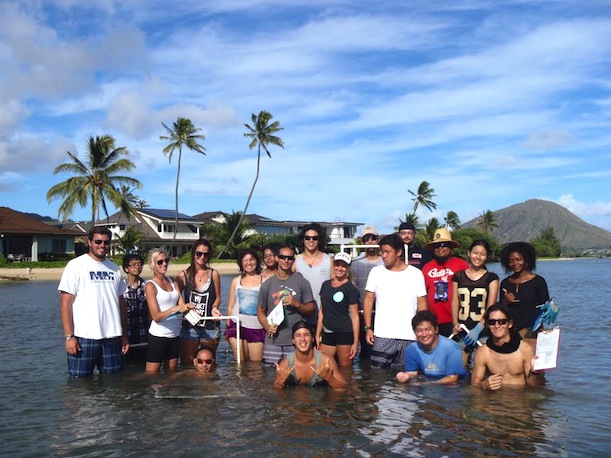By Ricci Franklin, Kapiʻo Staff Writer
In an ongoing effort to return Maunalua Bay to its former glory, Kapiʻolani Community College professor Wendy Kuntz and her BIOL 124L Environment and Ecology Lab class have assisted the environmental group Malama Maunalua in removing hundreds of pounds of invasive algae from from the East O‘ahu waterway this semester.
Kuntz — “Dr. K” to her students — first aligned her lab class with the community-based environmental group five years ago as a way to provide students with a practical, hands-on education in science and an opportunity to make a valuable contribution to their surroundings.
“When I started the Biology 124 Lab course, I wanted to find a long-term project where students could both learn ecology techniques and support their community,” said Kuntz, recipient of a 2013 Excellence in Teaching Award. “Malama Maunalua was a perfect partner and has helped us achieve both goals.”
Maunalua Bay, located in the Aina Haina, receives unfiltered runoff from 10 different area watersheds. Because of housing developments, roadways and storm drains, rain water is not able to soak into the ground and rid itself of toxins. Instead, it flows directly down concrete pathways, picking up trash, fertilizer, detergents, pet waste and other pollutants along the way before ending up in the bay
Over the years, polluted sediment has clouded the water of the bay, making it difficult for underwater vegetation to receive sunlight necessary for photosynthesis. Exacerbating the problem, invasive algae, originally brought in for experimentation and sale, has thrived in the murky conditions. The three main species are commonly known as leather mudweed, gorilla ogo, and prickly seaweed. These invaders have blanketed the bay, making it extremely difficult for other species to sustain themselves.
Malama Maunalua, founded in 2005, is a community-based organization that is dedicated to bringing life back to the bay. Focusing on the area that stretches along Paiko Beach, volunteers from the Maunalua community work together to pull the invasive algae. So far, over 3 million pounds of algae have been removed from the bay thanks to Malama Maunaloa’s efforts.
Runoff from the KCC campus also ends up in Maunalua Bay, making the work done by Kuntz and her students an act of environmental responsibility as well as service. During lab hours this semester, Kuntz and her students have convened at Maunalua Bay to help pull algae. Malama Maunalua marks off a specific area that needs attention, and the students go to work. This year, the lab class pulled 447 pounds of invasive algae in one lab session. This is a fairly standard amount for her classes to remove as part of ongoing maintenance. However, when Kuntz’s classes first started coming out, the yield was immensely higher.
“It was like a blanket,” Kuntz said of the algae. “We would get in and pull huge handfuls, large balls of the Avrainvillea amadelpha (leather mudweed). We would come out stinky.”
For more information on Malama Maunalua’s restoration efforts, visit www.malamamaunalua.org.

